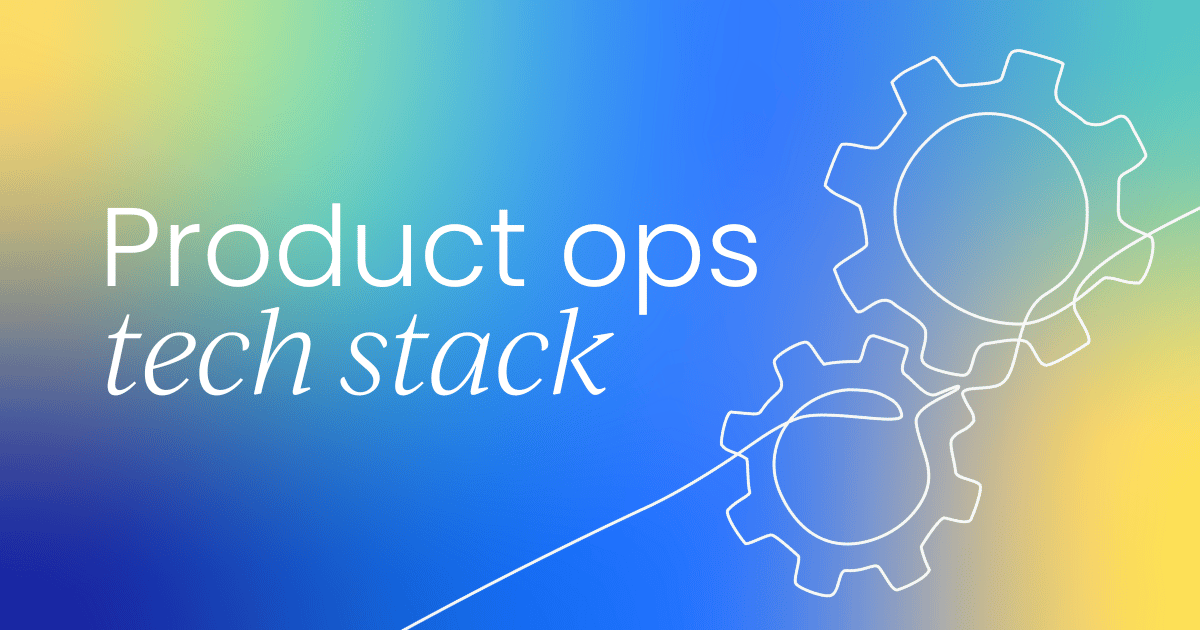If you’re still debating whether product operations is a "real" function, you’re looking at yesterday’s memo.
Our State of Product Ops Report 2025 confirms it: product ops is no longer the new kid on the block; it's the established connective tissue across the product organization, with 96% of organizations reporting they now have the function in some capacity.
Now that the debate on product ops' very existence is over, the focus has shifted to scaling its effectiveness.
The problem is that most teams are hitting an efficiency ceiling imposed by their current tech stack. A significant majority (64%) still report operating with low to moderate automation maturity. This creates a painful gap between the function's high aspirations (to be a strategic partner) and its daily execution (being bogged down by manual tasks).
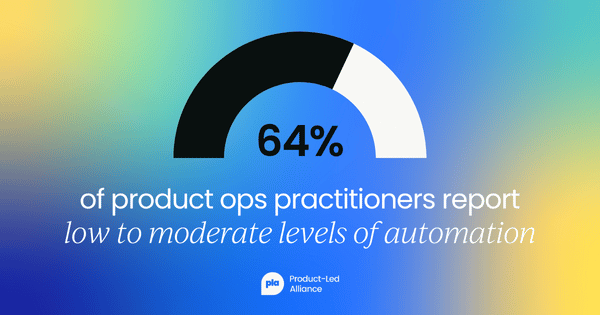
So, what's the solution? In 2025, the mature product ops tech stack is defined not by how many tools you buy, but by how well those tools are unified across three essential layers:
- Execution and workflow
- Strategy and alignment
- Insights and measurement
This whole system is now being accelerated by intentional investment in AI to drive automation and eliminate those cross-departmental silos that still plague product teams.
In this article, we’re going to break down the current tooling benchmarks, reveal where high-performing teams are making their strategic bets, and outline the tech stack you need to scale your influence beyond simply managing Jira tickets.
Let’s dive in.
The organizational foundation of a mature stack
Before you start throwing cash at new tech, you need the organizational structure to support it. Why? Because structure precedes stack. That means clear accountability, standardized processes, and one place for data to live. Without those foundations, even the best platforms are worthless. With them, your stack works as intended: streamlining, scaling, and adding value.
Our report highlights the dominance of centralized product ops functions, with 76% of teams now operating as a dedicated, centralized entity. That centralization provides a single point of process ownership and drives consistency.
But here’s the kicker: it simultaneously creates a massive operational headache – siloed tools and data sources. This is cited as the biggest daily challenge for 24% of dedicated product ops teams. Your tech stack must solve this, or centralization just means you have one person managing five different silos.
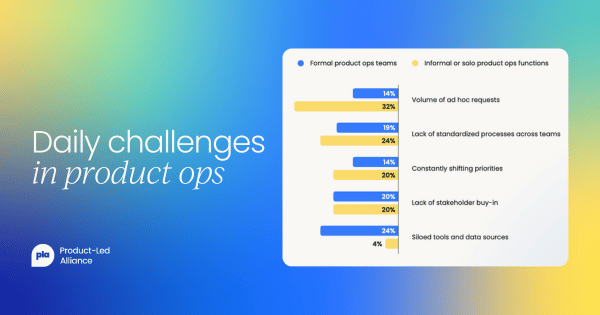
Next up: strategic sponsorship. Nearly half of dedicated product ops teams (48%) report straight into the Chief Product Officer – and that matters. This isn’t just a fancy title on the org chart; it’s a seat at the table where big bets are made.
With CPO-level visibility, product ops has the clout to secure investment in tools that align teams and enforce governance across the whole product portfolio. It moves you beyond task wrangling and into decisions that shape the entire business.
Ultimately, your tech stack has to support your foundational mandates: cross-functional alignment (cited by 93% as a core responsibility of the product ops function) and process optimization (cited by 90%).
If a tool isn't actively helping you nail those two things, you’re building technical debt, not adding business value.
The three non-negotiable layers of a product ops tech stack
When we dug into the data from the State of Product Ops Report, one pattern stood out. The teams with the most mature stacks weren’t just buying more tools; they were organizing them into three connected layers that function as one system.
Let’s take a look at those layers.
Layer 1: Execution and workflow (the operational backbone)
This is the non-negotiable layer. Workflow management is the most essential tooling category for product ops (34.6% rank it first, and nearly 60% place it in the top two).
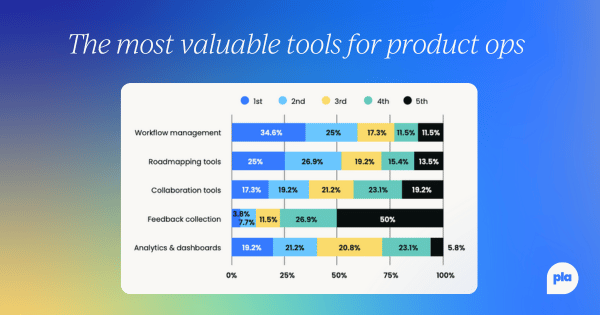
Tools like Jira, Asana, and Trello are the foundation of your day-to-day work. While 81% of product ops folks still manage basic tool administration, maturity means moving past that to genuine workflow optimization within these platforms.
Your tech stack then becomes the engine that centralizes issue tracking, masters team capacity, and, most importantly, standardizes all your processes across the platforms your product teams already use.
This layer ensures that when a product manager starts their day, the process is clear, the templates are ready, and the documentation is accessible. It's the engine room that keeps the lights on and the ship sailing smoothly. If this layer is a mess, the entire organization slows down, regardless of how good your strategy is.
Layer 2: Strategy and alignment (the visibility engine)
The high value placed on roadmapping tools (over 50% of respondents put it in their top two most important categories of tools) clearly demonstrates that product ops is successfully making the move upstream – from enabling delivery to enabling strategic planning.
The stack here is your visibility engine. We’re talking about platforms like Productboard, Aha!, or dedicated Advanced Roadmaps views in Jira – tools that go beyond a simple timeline. They enable product op’s increasing responsibilities in roadmap planning and annual planning alignment, packaging it into a coherent, defensible plan that leadership and stakeholders can understand.
In mature product ops functions, this layer of the tech stack doesn't just display a timeline; it's designed to enforce governance – which is a nice way of saying it stops people from going rogue. Here’s how that enforcement might look in practice:
- Mandatory alignment: The tool requires every new epic or feature (Layer 1) to be explicitly linked to a high-level company OKR. No link, no approval.
- Clear resource view: The platform connects initiatives to resource allocation data, giving leaders a real-time, visual view of capacity against the strategic roadmap.
- Data validation: It automatically ties shipped features to Layer 3 (Insights) metrics, guaranteeing that development work is consistently tied directly to the business outcomes you’re trying to achieve.
Layer 3: Insights and measurement (the data conductor)
While analytics and dashboards are a top-three tool priority, our data shows a slight disconnect: only 47% of product ops pros consider data reporting a core function (we suspect it’s often owned by separate analytics specialists).
This is where the mature stack distinguishes itself. It doesn't try to own the data infrastructure; instead, it acts as the data conductor, seamlessly connecting workflows and roadmaps to central analytics platforms, such as Amplitude, Mixpanel, or Tableau.
This layer is crucial because you cannot prove value without it. Right now, 54% of product teams lean on subjective internal metrics like product team satisfaction to measure success. That’s great, but it doesn’t pay the bills. You need a tech stack that effortlessly ties an executed feature (Layer 1) to its roadmap slot (Layer 2) and then to the resulting lift in revenue or customer retention (Layer 3).
Automation and AI in product ops
Our survey data points to a significant gap between aspirations and reality: only 7% report high automation, yet a massive 43% see AI and automation as the main focus for product ops in the next three years.
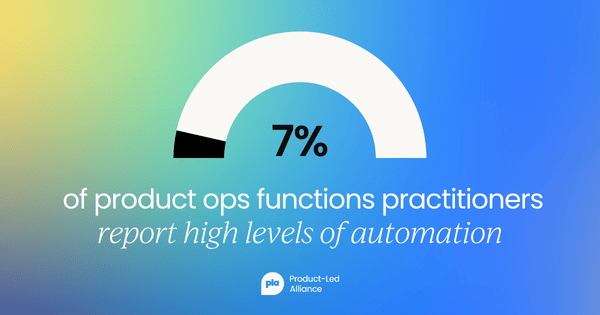
This gap is a clear opportunity to level up your tech stack. Automation is the fastest path to freeing product ops from busywork and giving the team space to operate strategically.
Current AI use case: Eliminating overhead
Today, AI’s main job is to handle the grunt work. In fact, 62% of teams are already using it to trim down the endless admin. The best teams push it further: they use AI to auto-tag incoming data and crank out those dreaded recurring reports – QBRs, MBRs, you name it.
Picture this: instead of juggling five data sources to write one update, AI does it for you. That’s an hour a day saved, just like that.
The future use case: Strategic insight and prediction
The real payoff on investments in AI and automation will come when teams use it to get proactive and predictive. This will move product ops from being a recorder of history to a shaper of the future.
23% of survey respondents say AI has helped their team improve decision-making with data-driven insights. Meanwhile, just 4% say it has led to improved accuracy of forecasting and trend analysis. These numbers are small today, but they represent the future state of the highest-performing teams.
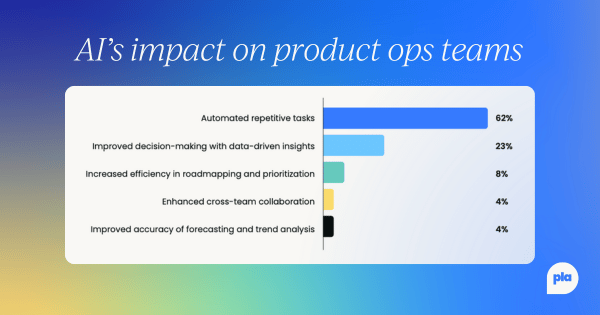
Amplifying the voice of the customer
50% of survey respondents ranked feedback collection tools last in the list of the most valuable tools. Yet, one of the highest priorities for product ops teams is enhancing customer feedback loops, with 28% citing it as the greatest opportunity for customer-facing impact..
The future belongs to tech stacks that bridge that gap. With AI tools that can sift through support tickets, sales notes, and survey comments, raw chatter becomes structured insight, ready to plug straight into the roadmap.

Three tips for building a high-powered product ops tech stack
A truly mature stack doesn't just manage internal product processes; it helps product ops drive external business value.
With that in mind, here are three tips to help you enhance your tech stack:
- Break down silos with real integration: The best stacks aren’t defined by shiny features, but by how well the tools talk to each other. Prioritize unified platforms or high-fidelity, two-way integrations that ensure data consistency across every system, from Jira to your reporting dashboard.
- Scale adoption and enablement with high-touch training: When you invest in tech, your investment isn’t just in the license; it’s in the training that ensures product managers actually use your shiny new tools.
- Drive external impact with GTM enablement: The tech you choose must support GTM execution, providing sales, marketing, and customer success with the information they need.
Conclusion
The modern product ops tech stack isn’t a patchwork of point solutions. It’s a unified, integrated system operating across those three essential layers: Execution, Strategy, and Insight. Together, these layers free product ops from firefighting and elevate it into a true strategic partner.
If you’re still buried in manual reports, your stack is already outdated. Now’s the time to invest in technology that not only streamlines your processes but also amplifies your influence – helping your team work on the business, shape the future, and drive measurable impact.



 Follow us on LinkedIn
Follow us on LinkedIn

